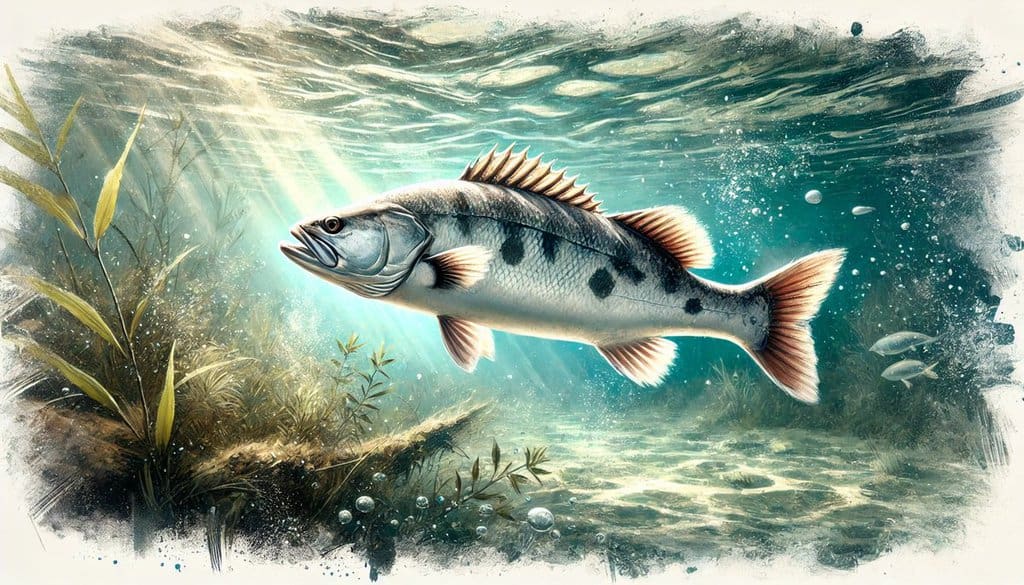Barramundi (Lates calcarifer), also known as Asian sea bass, is a popular fish species in aquaponics systems due to its rapid growth rate, adaptability, and high-quality flesh. This euryhaline species is prized for its ability to thrive in both freshwater and marine environments, making it versatile for various aquaponics setups[1][5]. The difference between the Giant Barramundi and Lagoon Barramundi is primarily based on the environment and size rather than species, as both are the same species: Lates calcarifer.
Giant Barramundi: This term typically refers to larger individuals of the species, often found in estuarine(where saltwater meets freshwater aka brackish water) or riverine environments where they have more room to grow. These fish can reach impressive sizes, sometimes exceeding 1.5 meters in length and weighing over 50 kilograms.
Lagoon Barramundi: This term usually refers to Barramundi found in smaller, more confined lagoon environments. Due to space and resource limitations, these individuals tend to be smaller compared to their river or estuarine counterparts.
Despite these habitat differences, both “Giant” and “Lagoon” Barramundi are the same species, with differences in size and sometimes behavior influenced by their respective environments.
Natural Habitat and Behavior
Origin and native environment: Barramundi is native to the Indo-Pacific region, inhabiting coastal waters, estuaries, and freshwater rivers[1].
Natural behavior in the wild: In the wild, barramundi are catadromous, meaning they migrate from freshwater to the sea to spawn[1].
Temperament: Barramundi can be aggressive and territorial, especially as they grow larger.
Compatibility: Due to their predatory nature, barramundi are best kept in single-species systems or with fish of similar size.
Water Requirements
Temperature Range:
- Ideal temperature: 24-32°C (75.2-89.6°F)
- Temperatures outside this range can stress the fish and impact growth rates[1].
pH Level:
- Recommended pH range: 6.5-8.5,
- Barramundi can tolerate slight pH fluctuations but prefers stable conditions[1].
Water hardness:
- Barramundi adapt well to various water hardness levels but prefer moderate hardness.
Oxygen Levels:
- Ideal dissolved oxygen levels: >5 mg/L
- Barramundi are relatively tolerant of low oxygen conditions but thrive with good aeration[1].
Ammonia/Nitrate Sensitivity:
- Barramundi are sensitive to high ammonia and nitrite levels. Maintain ammonia and nitrite close to 0 mg/L, and nitrate below 50 mg/L[1].
Tank or Pond Setup
Tank/Pond Size Requirements:
- Minimum recommended tank size: 1000 L (264 gallons) for juveniles
- Allow 50-100 L (13-26 gallons) per adult fish
- Stocking density: 10-20 kg/m³ (0.62-1.25 lbs/ft³) for optimal growth[1].
Filtration & Aeration:
- Barramundi requires efficient filtration and strong aeration due to their high metabolic rate and oxygen demand[1].
Lighting Considerations:
- Natural light cycles are sufficient, but avoid excessive direct sunlight to prevent algae overgrowth.
Tank Decorations/Substrate:
- Provide hiding spots with PVC pipes or large rocks to reduce stress and aggression.
Feeding Requirements
Diet:
- Barramundi are carnivorous and require a high-protein diet (40-50% protein)[1].
- Commercial pelleted feeds formulated for barramundi are ideal.
Feeding Techniques:
- Feed 2-3 times daily for juveniles, reducing to 1-2 times daily for adults.
- Adjust feeding rate based on water temperature and fish size (2-5% of body weight per day)[1].
Supplements or special diets:
- Supplementing with fish oil can improve growth and flesh quality[1].
Growth and Reproduction
Growth Rate: Barramundi grow rapidly, reaching 300-500g (0.66-1.1 lbs) in 6-8 months under optimal conditions[1].
Physical Growth Indicators: Juveniles have a more elongated body shape, which becomes deeper and more robust as they mature.
Breeding Behavior:
- Breeding barramundi in aquaponics systems is challenging due to their catadromous nature and complex life cycle[1].
- Controlled breeding typically requires specialized hatchery facilities with salinity manipulation.
Care of Fry:
- Fry require specialized care and are usually obtained from dedicated hatcheries for aquaponics systems.
Harvesting & Culinary Considerations
Growth to Harvest: Barramundi typically reach market size of 350-500g (0.77-1.1 lbs) in 6-8 months[1].
Culinary Uses:
- Barramundi has a mild, buttery flavor and firm, white flesh.
- It’s versatile in cooking, suitable for grilling, baking, or frying.
Recommendations for Ethical Harvesting: Use humane methods such as rapid chilling or electrical stunning to minimize stress.
Pros and Cons
- Fast growth rate
- Adaptable to various water conditions
- High-quality, marketable flesh
- Requires high-protein feed
- Can be aggressive, limiting polyculture options
- Complex breeding requirements
Overall Suitability: Best suited for intermediate to advanced aquaponics practitioners due to their specific care requirements and potential for aggression.
Common Health Issues and Solutions
Potential Diseases: Susceptible to viral infections such as scale drop disease virus (SDDV) and Lates calcarifer herpes virus (LCHV)[5].
Signs of Health Issues: Look for abnormal swimming behavior, loss of appetite, or visible lesions on the skin.
Treatment Recommendations: Maintain optimal water quality and implement strict biosecurity measures to prevent disease outbreaks[5].
Maintenance Tips for Long-Term Health
Maintenance Frequency:
- Regular water quality testing and system checks are crucial.
- Perform partial water changes (10-15%) weekly.
System checks: Monitor temperature, dissolved oxygen, pH, and nitrogenous compounds daily.
Handling Practices: Minimize handling to reduce stress. When necessary, use nets with a soft, knotless mesh.
Winter/Summer Care: In outdoor systems, provide temperature control to maintain optimal conditions year-round.
Tank Compatibility and Stocking: Barramundi are best kept in single-species systems due to their predatory nature.
Closing Thoughts
Barramundi is an excellent choice for aquaponics systems due to its rapid growth and high market value. However, successful cultivation requires careful management of water quality, feeding, and system design. While challenging for beginners, experienced aquaponics practitioners can achieve impressive results with this species.
More fish species for aquaponics
External sources:
[1] https://www.ncbi.nlm.nih.gov/pmc/articles/PMC8230191/
[2] https://www.semanticscholar.org/paper/feb07971216c9c065a4530bd96baace4813a79cc
[3] https://www.semanticscholar.org/paper/919aac84a4ec53d9f8816674562a3d4d46e43483
[4] https://www.semanticscholar.org/paper/c602a7a9280a0c67fe3906eb06c5b5d458591f40
[5] https://www.ncbi.nlm.nih.gov/pmc/articles/PMC8249934/
[6] https://www.semanticscholar.org/paper/20cee9b2bb4417074939bc6188e8447d47f4a62c

